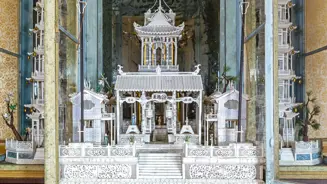A rare and mysterious Chinese ivory pagoda is the new attraction of the National Palace of Queluz
31 Mar 2022
The most recent novelty of the exhibition route of the National Palace of Queluz is a piece that continues to challenge researchers after more than two centuries. It is a rare Chinese pagoda in ivory, wood and bone produced during the Qing dynasty in the late 18th or early 19th century, and whose presence in the royal collections remains a mystery. What is certain is that it belonged to Queen Carlota Joaquina, having formed part of the decoration of her Ramalhão Palace in Sintra. It is also known that it was transferred to the National Palace of Sintra twenty years after her death in 1850 by order of her granddaughter, Queen Maria II. More than 150 years later, the life of this piece, the only one known in Portugal with these characteristics and dimensions, enters a new stage, now at the National Palace of Queluz, where, in a setting more associated with its past, it will continue to be studied by Parques de Sintra.
As a result of Portugal's privileged contacts with Asia, the National Palace of Queluz has been an important repository of porcelains, textiles, lacquerware and other pieces described in documents since the mid-18th century. It is known, for example, that in 1785, the year she arrived in Portugal from Spain, the young Princess Carlota Joaquina had in her bedroom of this Palace a Chinese bed in wood painted white and gold, "with much woodwork and very rich ornate with inlays and feet showing creatures bearing theirs tongues," and decorated "with two oval-shaped Chinese phrases carved in its frame." As a result of the vicissitudes of history, little remains of the oriental objects mentioned in the inventories today. As such, the pagoda currently displayed in this palace allows us to evoke a component of the courtly taste that marked royal life at Queluz between the late 18th and early 19th century. The piece's connection to Queen Carlota Joaquina is reinforced by its position in a room that visually communicates both with the room containing a large portrait of the monarch by João Baptista Ribeiro and with the Dining Room, whose table is host to an English service in porcelain decorated with the initials CJPB (Carlota Joaquina Princesa do Brasil), also from the Palace of Ramalhão.
In truth, the piece is a miniature recreation of an entire architectural ensemble, consisting of several pavilions or temples and flanked by two pagoda-shaped towers with wooden structures, entirely covered in ivory and bone. It is developed over a succession of planes interspersed by courtyards, gardens and staircases, where we find the figures of human, animals and trees, among other decorative elements such as small bells suspended from the corners of the roofs. The ensemble is protected by a glazed wooden period structure that fits the three main bodies and is set on a base with classical mahogany columns. Although several pieces of this type exist in public and private collections around the world, including in the Guimet National Museum of Asian Arts in Paris, which has a similar piece to the central set of pavilions, the Queluz pagoda is of particular note due to the size of its towers, which, at almost two metres in height, are the tallest among all known similar pieces.
Through synergies with a wide range of institutions, Parques de Sintra collaborated with the Department of Conservation and Restoration of the Faculty of Science and Technology at the NOVA University of Lisbon in the complex process to disassemble, package and transport the pagoda from the National Palace of Sintra to the National Palace of Queluz. As part of the "Caring for Collections" programme, six final-year students of the Conservation and Restoration degree participated in these operations, taking the opportunity to consolidate their theoretical knowledge through practical experience in a real work context.
The need to continue study of this piece also gave rise to a partnership with the Scientific and Cultural Centre of Macau, from whom Parques de Sintra requested support in the survey and translation of several inscriptions engraved on the ivory plates that make up the pagoda. Their content may reveal new clues and finally unravel the mystery surrounding the date and circumstances of this piece's arrival in the royal collections. Oral tradition refers to a gift from the Senate of Macau, but the lack of documentary support has never allowed this theory to be proved, or clarified whether the miniature represents a religious building or, possibly, the palace of the Emperor, so there are many questions that continue to hang over the enigmatic Chinese pagoda.

